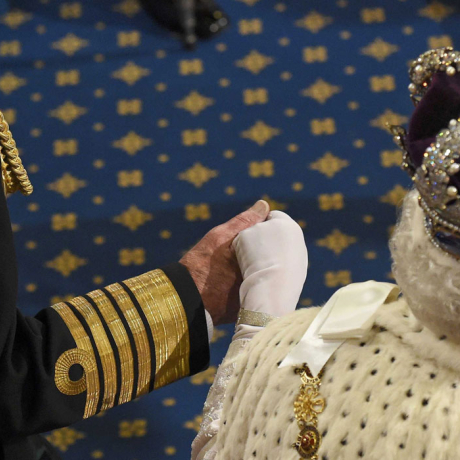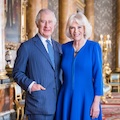The Queen's Consort
The Duke of Edinburgh was devoted consort (companion to the Sovereign) for over 60 years, from Her Majesty’s Accession in 1952 until his death.
He has quite simply been my strength and stay all these years , and I, and his whole family, and this and many other countries, owe him a debt greater than he would ever claim, or we shall ever know
The Queen, in a speech to mark the couple's Golden Wedding Anniversary
In 2009 he became the longest serving British consort, a distinction previously held by Queen Charlotte, George III’s consort.

The role of The Queen’s consort is primarily to provide companionship and moral and practical support to the Monarch.
The consort does not hold a formal position in the structure of government and The Duke did not see State papers or hold official audiences.
However, Prince Philip established a significant role for himself in his own right, creating an extensive and important portfolio, based on his personal interests, all of which he carried out in support of Her Majesty's duties.
The early reign
The husband of a reigning Queen, unlike a Queen Consort, is not crowned or anointed at the coronation ceremony. In 1953 The Duke of Edinburgh was, however, the first peer to ‘do homage’ or pay his respects to The Queen, immediately after the Archbishops and Bishops.
Watch footage from The Queen's Coronation:
I, Philip, Duke of Edinburgh, do become your liege man of life and limb, and of earthly worship; and faith and truth I will bear unto you, to live and die, against all manner of folks. So help me God
The Duke of Edinburgh, at The Queen's Coronation
In September 1952, shortly after her Accession to the throne, The Queen granted Prince Philip "place, pre-eminence and precedence" next to herself, a position normally reserved for the Heir to the Throne; and on 22 February 1957 she created him a Prince of the United Kingdom so that his title was from then on His Royal Highness The Prince Philip, Duke of Edinburgh.
From 1967 he sat on a consort’s throne placed next to that of The Queen at the State Opening of Parliament.
Supporting The Queen
His portfolio of work aside, The Duke of Edinburgh always maintained that his first duty was to support The Queen in her programme of public engagements and ceremonial duties from visiting local charities to hosting Heads of State during State Visits.

Prince Philip accompanied Her Majesty on all of her Commonwealth tours and State Visits overseas, as well as on tours and visits throughout the United Kingdom whenever possible. On some visits, he carried out a parallel itinerary of engagements to complement The Queen’s programme.


On his own he travelled all over the world, often representing The Queen during visits to remote parts of the Commonwealth which could only be reached by sea and where the arrival of Her Majesty’s Yacht Britannia was greeted with great enthusiasm.
In 2017, Her Majesty appointed The Duke of Edinburgh to be a Knight Grand Cross of the Royal Victorian Order (GCVO) in recognition of his years of service.
The Duke of Edinburgh's role
The Duke of Edinburgh was an advocate for scientific and industrial progress, technological modernisation and the conservation of wildlife and the institutions that advanced these causes.
He became Chancellor of four universities (Wales, Edinburgh, Salford and Cambridge) and in 1956 he instituted The Duke of Edinburgh's Award to encourage the concept of service and the physical development of young people.
His Royal Highness had a hands-on approach, preparing all of his own speeches. Notably, his 1951 Presidential Address to the British Association for the Advancement of Science in Edinburgh was entitled ‘The British Contribution to Science and Technology in the past 100 years’ and was written in his cabin in HMS Magpie while he was serving in the Mediterranean. The speech was given 100 years after his great-great-grandfather, Prince Albert, had held the same position.
The Duke of Edinburgh also followed in the footsteps of his great-great-grandfather Prince Albert by becoming President of the Royal Commission for the Exhibition of 1851, and became President of the Prince Albert Trust in 1996.
Against this background, and with his many other interests, he carried out a very full programme of public engagements involving much travelling at home and abroad.
The management of the Royal Household
The Duke of Edinburgh was significantly involved in modernising the running of Buckingham Palace after Her Majesty became Queen, adapting the Palace for both family and office life.
His Royal Highness was particularly interested in the work of his own office, designing the method for filing papers and the system of rotating shelves to hold them, which are still in use today, and introducing a dictograph internal communication system in the 1950s.

The Duke of Edinburgh was always interested in the latest technology. In the 1980s he used one of the first personal computers, a British-made ‘Apricot’, and continued to use computers for the rest of his life to write letters, speeches and books. As early as 1953 he had a radio telephone fitted in his personal car.
His Royal Highness was closely involved in the running of his own office and its administration which engendered loyalty amongst his staff, many of whom worked for him for decades, some continuing beyond retirement on a voluntary basis.
The management of The Queen’s private estates
On succeeding her father, King George VI in 1952, The Queen asked The Duke of Edinburgh to take responsibility for the Royal estates at Windsor, Sandringham and Balmoral, and he was involved in all the strategic decision making from until 2017, when The Prince of Wales took responsibility for Sandringham and Balmoral.

One of the main guiding principles of management by the resident Land Agents has been to maintain the Estates for this and future generations. Conservation steps have been taken over the years, including, for example, at Sandringham where over two million trees and 40 kilometres of new hedges have been planted and 45 new woodlands and ten wetlands created.

Prince Philip showed great interest in and gave his whole-hearted support to the creation of the Windsor Farm Shop in a disused stable block. This successful business sources most of its fresh flowers, fruit and produce from the Royal estates.
As an Honorary Life Member of the Royal Association of British Dairy Farmers (RABDF) and former President, His Royal Highness presented the Prince Philip Annual Award for Research or Development in the Field of Dairy Farming. He often encouraged the managers of the Royal estates to be open to the latest ideas of farming technology put forward by members of the RABDF and other branches of the industry.
Prince Philip also put his practical experience of farming into use when, as President of the Royal Agricultural Society of England, he founded the Royal Agricultural Society of the Commonwealth in 1957. He attended the Society’s biennial conferences which were held in all parts of the Commonwealth to discuss common problems and some particular to the host country.
Recognition of individual success
In 1956 The Duke of Edinburgh initiated a new format of lunches at Buckingham Palace to which a cross-section of people from British life were invited by The Queen to recognise their individual achievements and these lunches still continue to this day.
A typical party might contain an academic, a member of the medical profession, a civil servant, a sportsman or woman, a journalist, an artist and a television presenter.
In July 1972 for example, the lunch party included Yuri Gargarin, Soviet cosmonaut, who happened to be visiting London and came with the Russian ambassador.



